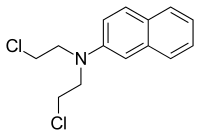Chlornaphazine
Chlornaphazine, a derivative of 2-naphthylamine, is a nitrogen mustard that was developed in the 1950s for the treatment of polycythemia and Hodgkin's disease.[1] However, a high incidence of bladder cancers in patients receiving treatment with chlornaphthazine led to use of the drug being discontinued.[2]
 | |
| Names | |
|---|---|
| IUPAC name
N,N-bis(2-Chloroethyl)naphthalen-2-amine | |
| Other names
Chlornapazine; 2-Naphthylbis(chloroethyl)amine | |
| Identifiers | |
CAS Number |
|
3D model (JSmol) |
|
| ChEMBL | |
| ChemSpider | |
| ECHA InfoCard | 100.007.078 |
| KEGG | |
PubChem CID |
|
| UNII | |
CompTox Dashboard (EPA) |
|
InChI
| |
SMILES
| |
| Properties | |
Chemical formula |
C14H15Cl2N |
| Molar mass | 268.18 g·mol−1 |
Except where otherwise noted, data are given for materials in their standard state (at 25 °C [77 °F], 100 kPa). | |
| Infobox references | |
The International Agency for Research on Cancer has listed chlornaphazine as a human carcinogen.[3]
References
- Videbaek, A.; Kaae, S. (1954). "2-Naphthylbis(chloroethyl)amine in the treatment of malignant diseases, particularly Hodgkin's disease". Acta Medica Scandinavica. 149 (5): 361–368. doi:10.1111/j.0954-6820.1954.tb11446.x. PMID 13180246.
- Benedicte Laursen (1970). "Cancer of the Bladder in Patients Treated with Chlornaphazine". Br Med J. 3 (5724): 684–685. doi:10.1136/bmj.3.5724.684. PMC 1701774. PMID 5470116.
- N,N-Bis(2-Chloroethyl)-2-Naphthylamine (Chlornaphazine), International Agency for Research on Cancer
This article is issued from
Wikipedia.
The text is licensed under Creative
Commons - Attribution - Sharealike.
Additional terms may apply for the media files.